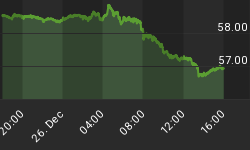The good news is:
• New lows have dried up on both exchanges.
• All of the Summation indexes are moving upward.
The dramatic decline in new lows since the May bottom tells us that the lows of May are unlikely to be seriously challenged. Upward moving summation indices tell us their underlying oscillators are positive. Combined these indicators assure us the intermediate term outlook for the market is positive.
The short term, some of the indicators raise doubts. The chart below plots the NASDAQ composite in red, a 4% trend (55 day EMA) of upside volume in green and a 4% trend of downside volume on an inverted Y axis in purple. Downside volume made a double (or triple) bottom about May 1st and has been diminishing rapidly since the price low in mid May. Upside volume increased for a few days after the mid May bottom but then resumed its down trend. This indicates the strength of the last 2+ weeks of this rally is not based on buying enthusiasm, but simply a lack of sellers.

The next chart plots the NASDAQ composite in red, a 10% trend (19 day EMA) of NASDAQ new highs in green and a 10% trend of NASDAQ new lows on an inverted Y axis in blue.
New lows diminished rapidly after the May bottom sending the new low indicator sharply upward, but there is been very little build up of new highs.

Summer doldrums, perhaps, but the picture last year at this time was different as the chart below of the NASDAQ volume indicators shows enthusiastic buying and selling.

Except for the last leg of a bull market, the small caps lead both up and down. The chart below shows the Russell 2000 (R2K) in red, the S&P 500 (SPX) in green and Accutrack, a FastTrack relative strength indicator as a histogram in yellow. After a strong rally off the May bottom, the small cap leadership has been faltering.

Next Friday is options expiration and historically the week prior to options expiration has been a little weak.
Witching report for June.
Witching is futures and options expiration the 3rd Friday of the month.
The witching Friday is marked *Fri*.
The number following the year is the position in the presidential cycle.
The report is calculated as trading days prior to the 3rd Friday.
| R2K | |||||
| Year | Mon | Tue | Wed | Thur | *Fri* |
| 1989-1 | -0.03% | -0.40% | -0.14% | -0.78% | 0.24% |
| 1990-2 | 0.09% | 0.56% | 0.49% | -0.14% | 0.16% |
| 1991-3 | -0.19% | -0.33% | -1.00% | -0.24% | -0.04% |
| 1992-4 | -0.28% | -0.55% | -1.83% | -0.89% | 0.35% |
| 1993-1 | 0.11% | 0.27% | -0.14% | -0.07% | -0.41% |
| 1994-2 | -0.09% | 0.31% | 0.05% | 0.19% | -0.53% |
| 1995-3 | 0.45% | 0.64% | 0.22% | 0.52% | 0.18% |
| 1996-4 | -0.32% | -1.38% | -0.53% | -0.88% | 0.31% |
| 1997-1 | 0.03% | 0.09% | -0.02% | 1.03% | -0.73% |
| 1998-2 | -1.75% | 1.04% | 1.30% | -0.97% | -0.31% |
| 1999-3 | -1.48% | 0.57% | 1.66% | 0.49% | 0.38% |
| 2000-4 | -2.78% | 1.03% | -0.79% | 0.51% | 0.29% |
| 2001-1 | -0.92% | 0.00% | -0.36% | -1.93% | -0.05% |
| 2002-2 | 2.54% | -0.22% | -1.45% | -0.58% | 0.18% |
| 2003-3 | 1.73% | 0.12% | -0.11% | -1.57% | -0.17% |
| Avg | -0.19% | 0.13% | -0.18% | -0.35% | -0.01% |
| Win% | 40% | 64% | 33% | 33% | 53% |
| SPX | |||||
| Year | Mon | Tue | Wed | Thur | *Fri* |
| 1989-1 | -0.14% | -0.71% | -0.02% | -1.16% | 0.40% |
| 1990-2 | 0.81% | 1.28% | -0.37% | -0.55% | 0.00% |
| 1991-3 | -0.57% | -0.41% | -0.92% | 0.09% | 0.62% |
| 1992-4 | 0.13% | -0.48% | -1.48% | -0.32% | 0.68% |
| 1993-1 | 0.10% | -0.32% | 0.26% | 0.25% | -1.08% |
| 1994-2 | 0.09% | 0.71% | -0.38% | 0.29% | -0.75% |
| 1995-3 | 0.56% | 0.97% | 0.08% | 0.12% | 0.50% |
| 1996-4 | -0.10% | -0.47% | -0.02% | 0.02% | 0.72% |
| 1997-1 | 0.07% | 0.06% | -0.60% | 1.00% | 0.08% |
| 1998-2 | -1.99% | 0.98% | 1.79% | -0.07% | -0.52% |
| 1999-3 | 0.03% | 0.55% | 2.25% | 0.71% | 0.22% |
| 2000-4 | -0.75% | 1.62% | 0.07% | 0.56% | -0.97% |
| 2001-1 | -0.84% | 0.12% | -1.13% | -1.75% | -0.45% |
| 2002-2 | 2.87% | 0.09% | -1.65% | -1.34% | -1.70% |
| 2003-3 | 2.24% | 0.09% | -0.16% | -1.52% | 0.10% |
| Avg | 0.17% | 0.27% | -0.15% | -0.24% | -0.14% |
| Win% | 60% | 67% | 33% | 53% | 60% |
The market is overbought for the short term, and the advances of the past two weeks have been driven by a lack of sellers, not enthusiasm of buyers. Seasonally the week has had a slight negative bias.
I expect the major indices will be lower on Friday June 18 than they were on Thursday June 10.
Last weeks negative forecast was a miss as all of the major indices were up.
















